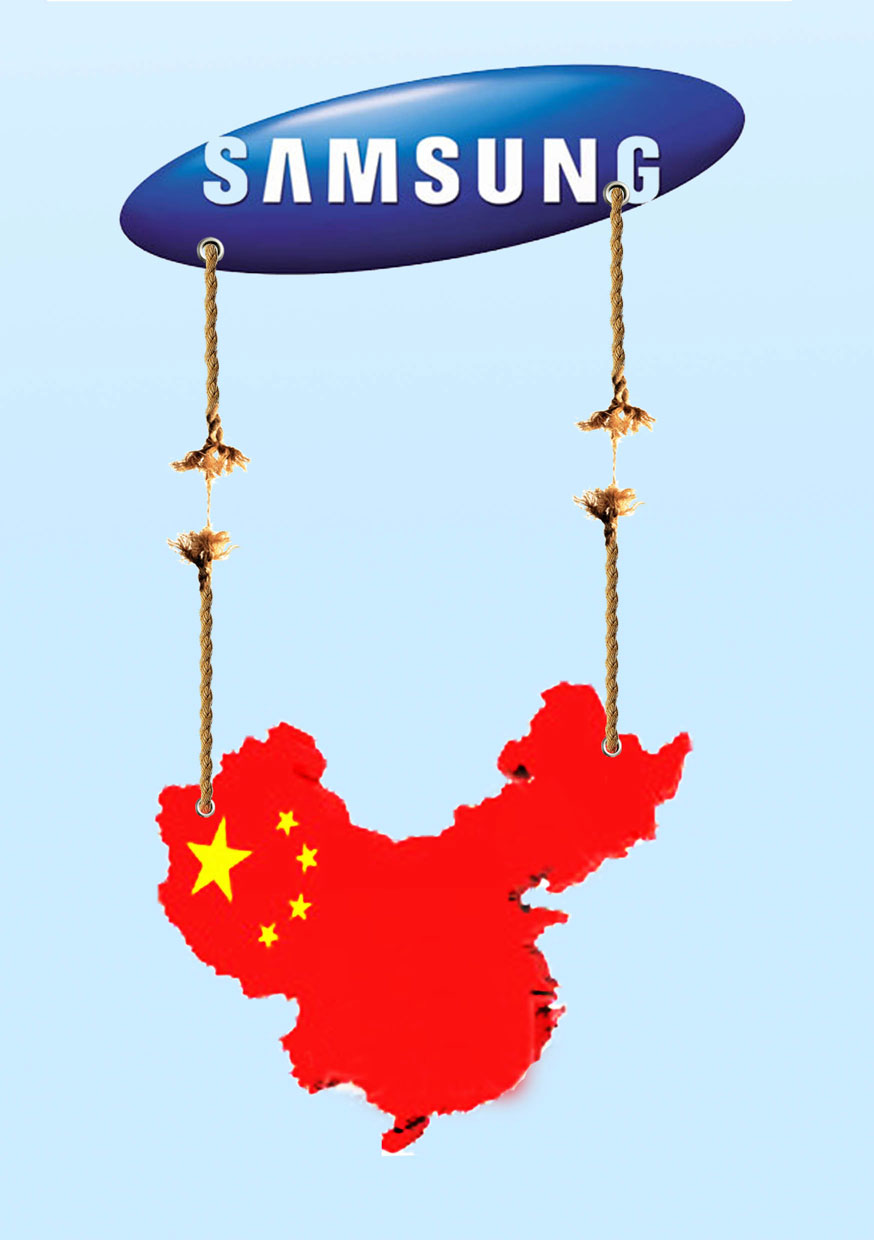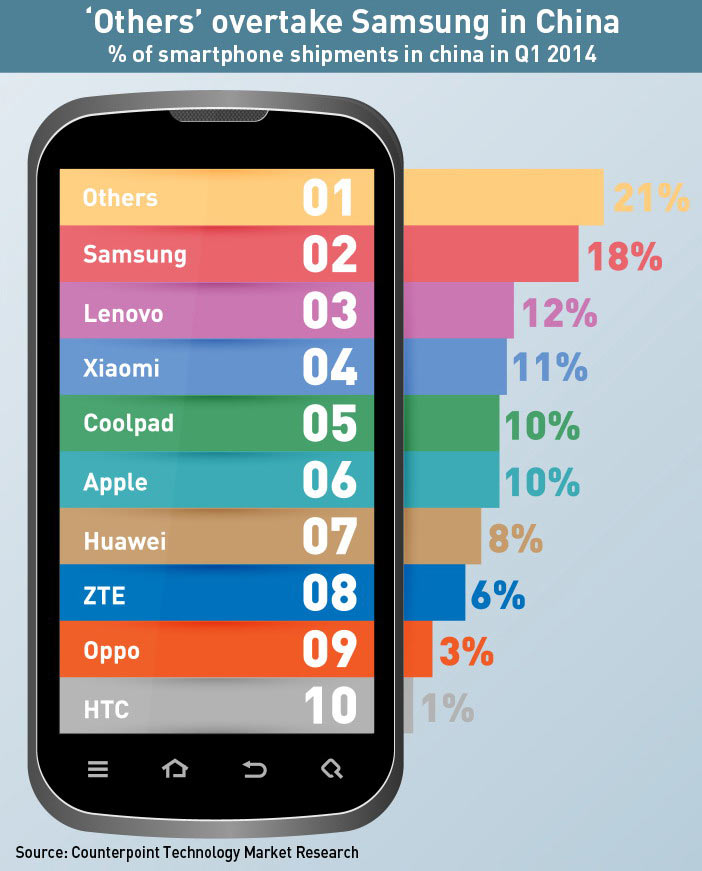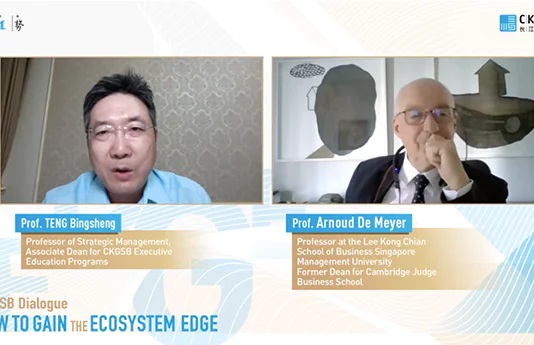
Samsung in China is not where it used to be. Can the South Korean electronics giant fend off domestic brands and Apple to stay at the top of China’s smartphone market?
Until recently, South Korean tech giant Samsung Electronics has enjoyed the title of undisputed champion in China’s smartphone market since 2012, jamming retail channels to the point of near omnipresence with handsets that seemingly combine up-market sensibilities with the pervasiveness of the Android operating system.
But recent drops in operating income—the most recent nearing 25% in the second quarter of the year—has mobile market watchers wondering if the company’s slip is beginning to show in China.
As competition intensifies at the bottom of the market and sales growth at the top slows, Samsung’s reported profit margins—roughly flat at 19.8% at the end of the first quarter of 2014 compared to a year ago—are coming under intense pressure. Apple—recovering nicely from its run-in with state media last year and lackluster rollout of the iPhone 5C, thanks largely to its deal with China Mobile—is luring away Samsung’s high-end users. At the same time, Chinese vendors are co-opting the Android operating system into inexpensive handsets tailored to the local market, rendering consumers hard pressed to delineate what makes Samsung mid-market phones worth the price.
“Outside of the premium segment, Chinese handset makers have pulled even with Samsung on hardware,” says James Yan, a technology analyst with IDC Research in Beijing.
With less and less distinguishing Samsung handsets from that of its Chinese competitors, the chaebol is at a crossroads in China, which accounted for 18% of Samsung’s revenue in 2013, according to a Sino Market Research report released in May of this year. Further emphasizing Samsung’s tenuous China positioning is its reliance on handsets, which make up 76% of the company’s total income, according to company reports.
“Samsung is in a precarious situation,” says Jeff Pu, an analyst with Yuanta Securities in Taipei and former head of market intelligence in Taiwan for Samsung SDI, an affiliate of the electronics giant. “China is very important to them—there is no way they can ignore a market that size—but sales are not good and Samsung has not done anything to give investors reason to believe they will improve.”
Among Samsung’s underwhelming countermeasures is the development of a mobile operating system of its own called Tizen, of which analysts are rightfully skeptical. On the premium hardware side, Samsung will release its high-end flagship Galaxy Note 4 in October with a curved screen, a novel feature it hopes will win over Chinese consumers.
Unfortunately, none of these moves heralds a paradigm shift for Samsung. With the commoditization of smartphones in China, Samsung will be unable to rely on its hardware and brand strengths alone to justify premium pricing. Nor can it accept razor-thin margins like some of its Chinese competitors who hedge their smartphone revenues by expanding into different product lines. Without a reboot of Samsung’s China strategy, the South Korean conglomerate’s share of the world’s largest mobile market looks set to fast erode.
Samsung in China: Still Number One?
 For now, Samsung remains at the top of the China handset market with 18% market share through the first quarter of 2014, down from 20% a year earlier, according to the research firm Canalys.
For now, Samsung remains at the top of the China handset market with 18% market share through the first quarter of 2014, down from 20% a year earlier, according to the research firm Canalys.
But in late June, CFO Lee Sang-hoon told reporters in Seoul that the company’s Q2 earnings report wouldn’t “look too good”. He was right. Operating income fell nearly 25% to 7.2 trillion won ($7.1 billion) in the second quarter, the third straight quarterly drop, driven down by cheap Chinese handsets and a strong won.
Samsung does not disclose smartphone shipments, but analysts say it sold about 78 million units in the three months leading up to June—short of the 90 million units expected.
“The company witnessed a slowdown in the overall smartphone market growth and saw increased competition in the Chinese and some European markets,” Samsung said in an explanatory note to investors.
What makes the downturn more perilous is China’s tendency to chew up mobile leaders and spit them out as shells of their former selves.
Here Today, Gone Tomorrow
If its China smartphone sales fail to pick up, Samsung may go the way of Motorola and Nokia. Both firms once led the China mobile market within the last decade,but couldn’t adapt to changing market conditions—intensifying competition in particular—and saw their market shares plummet. Motorola withdrew last year while Nokia holds on to less than 1% of the market.
According to Vanessa Zeng, a senior analyst with Forrester Research in Beijing, has-beens are common in a market where Chinese consumers, accustomed to a deluge of new handset models, change their phones regularly. Their lack of brand loyalty naturally favors newcomers.“You could say Samsung was one of the main benefactors of Nokia and Motorola’s collapses in China,” she says. “Samsung picked up many of their high-end users.”
Despite competition from Apple, Samsung’s high-end user base remains solid. But domestic brands with low overheads, eager to gain a foothold in the market, are undercutting Samsung in its vast middle and lower tiers. One of the fiercest such competitors is Xiaomi, China’s number three-handset maker behind Samsung and Lenovo. In 2013, Xiaomi sold 18.7 million smartphones almost exclusively from its website, generating $5 billion in revenue. “They can accept very low margins, almost zero,” says Nicole Peng, director of research at Canalys in Shanghai. “Samsung can’t compete with that.”
Horace Dediu, an independent analyst who previously worked for Nokia in the 2000s, predicted two years ago that cheap Chinese handsets would be Samsung’s undoing. As Chinese brands narrowed the hardware gap with Samsung, the company’s lack of software and services—drivers of future growth in the handset sector in his view—would hamstring it, he wrote on his online tech analysis portal, Asymco.com.
Made For China
Dediu’s forecast was spot on. Between the first quarters of 2013 and 2014, Xiaomi nearly quadrupled its share of the China smartphone market from 3% to 11%, Canalys found. In the three months leading up to April this year, Xiaomi’s RedMi, which retails for RMB 980, was the top-selling handset in China, with nearly one-fourth of its buyers switching over from Samsung, said the consultancy ComTech in a June research note.
Xiaomi has cut into Samsung’s market share with an aggressive localized strategy. It eschews retail outlets, instead selling its inexpensive, high-performance handsets online, where Chinese consumers increasingly prefer to shop. It does little conventional advertising, earmarking just 1% of its revenue to marketing, compared to Samsung’s 5.4%. Xiaomi also channels the tremendous reach of China’s social networks, Weibo and Wechat, to bring users into an integrated platform that includes software and internet services tailored to the Chinese market.
Xiaomi’s strategy has gone one step further by applying consumer feedback in rapid fire fashion in the subsequent editions of the handset and its software, a tack that has made the phone maker considerable gains. Not only is it now China’s number three smartphone vendor, but its users are fiercely loyal, a rarity in China. Xiaomi interacts closely with its tech-geek fans on social media, and invites them to its promotional events, says James Yan of IDC Research. Combined with its software and services, that leads to stronger brand loyalty than is seen with other domestic handset makers, he adds.

Number two Lenovo, whose market share rose from 9% to 11% between the first quarters of 2013 and 2014, also threatens Samsung. Chen Xudong, Lenovo’s China president, said last year that his company aims to surpass Samsung’s China smartphone sales within two years. Lenovo already challenges Samsung in the lower end of the market, but it will not stop there. Last year, Lenovo released its first premium handset, the K900, to compete with the Samsung Galaxy.
Meanwhile, arch-rival Apple began selling iPhones last December through China Mobile, the world’s largest carrier with 772 million subscribers. Thanks to that agreement, Apple’s Q2 sales in China rose by around 13% year-on-year. The deal has thus far ensured the iPhone 6, due out in September, will be available to Chinese consumers at heavily subsidized prices. “The iPhone 6 is going to sell in huge volumes in China because of that deal,” says Jeff Hu of Yuanta Securities. “Samsung has no way to beat Apple in China this year.”
The best Samsung can do is leverage its core hardware strengths as it launches the Galaxy Note 4, Hu says, adding that it be the first mobile phone with a 4k (ultra high-definition) screen.
Prescriptions for Recovery
For Samsung,it’s all about core strengths according to analysts. Peng of Canalys believes Samsung should launch a new smartphone line just for the China market and sell it exclusively online to generate buzz. The smartphones should be priced to compete with domestic Chinese rivals, but should not comprise too large a part of the product line. “You want a balanced portfolio,” she says. “Having too many low-end phones could impact the performance of the high-end models.”
Given the strength of the Samsung supply chain, the company can easily launch new products faster than its competitors, Peng says. “They have the scale. We’re talking about a company that ships almost 90 million smartphones per quarter.”
Samsung’s vertical integration is one of its largest competitive advantages. Because the company began as a hardware manufacturer—it produces application processors, DRAM, NAND flash and displays, four of the most valuable components in handsets—and later expanded into end products, components have always generated profits for Samsung. By contrast, its competitors acquire components at a cost from external suppliers. In Apple’s case, that supplier is Samsung.
In contrast to its strong supply chain and hardware, Samsung is weak in software, relying on the same operating system as its Android-based competitors. That lack of software differentiation has prompted the company to develop its own Tizen operating system to reduce its dependence on Google. Analysts expect Samsung to launch a Tizen-based handset in China at the end of this year or early in 2015, but the new OS faces a major uphill battle in China.
First, Tizen will have to contend with Chinese regulators. Beijing has openly expressed its dissatisfaction with Google and Apple’s dominance of China’s handset software market for national security reasons. There is little reason to believe Chinese authorities would be supportive of yet another foreign operating system, especially since they have been busy creating their own, the China Operating System (COS), developed jointly by the Chinese Academy of Sciences and private-sector partner Liantong Network Communications Technology. China Telecom and China Mobile are currently testing the COS platform.
At the same time, Android is entrenched in the China market. Chinese consumers accustomed to the localized Android ecosystem will not easily switch over to something unfamiliar, even if it comes attached to a reputable brand like Samsung. Smartphones typically require app stores with tremendous variety to gain traction with users, and Tizen has almost no apps. “It’s too risky for Samsung to abandon Android in China,” says Hu of Yuanta Securities. “The Tizen ecosystem is too immature,” he says.
And therein lies the crux of Samsung’s software issues. It’s stuck with Android if it succumbs to short-term pressures, which will ultimately hurt its chances of maintaining a sustainable advantage over the competition.
According to Zeng of Forrester Research, Samsung needs to stay focused on the premium segment of the China handset market, where margins are much higher. In Zeng’s view, with its Galaxy Note models, Samsung remains superior to Chinese brands, competing only with Apple. “Apple will not launch a low-end smartphone in China, and so Samsung shouldn’t either,” she says.
To Zeng’s point, premium handsets are increasingly showing themselves to be Samsung’s bread and butter. An unnamed Samsung executive told Korean media earlier this year that it expected the Galaxy S5 model to sell 35 million units in the second quarter of 2014. For perspective, Samsung’s total global smartphone sales for the first quarter of 2014 reached 89 million, meaning just the one premium model is generating nearly 40% of sales.
But locking horns with Apple will become decidedly more treacherous if the rumored release of a large-screen iPhone 6 goes well.
“Apple is not engaging in a simple hardware competition,” says Zeng. “It invests more time than Samsung in developing genuinely innovative new products. If the big-screen iPhone 6 lives up to the hype, it will have a major impact on Samsung’s China sales.”
Other emerging markets offer Samsung opportunity to rebalance, says James Yan of IDC Research, but he does not expect the South Korean electronics giant to dial down its presence in China. “Samsung will step up its smartphone shipments in Russia and India, which are two of the largest emerging markets,” he says. “But China will remain a crucial market for Samsung because of its size and the huge investments Samsung has made here.”
That’s a position Samsung may want to rethink as Chinese device makers are casting ever bigger shadows over the current market forerunners.



















